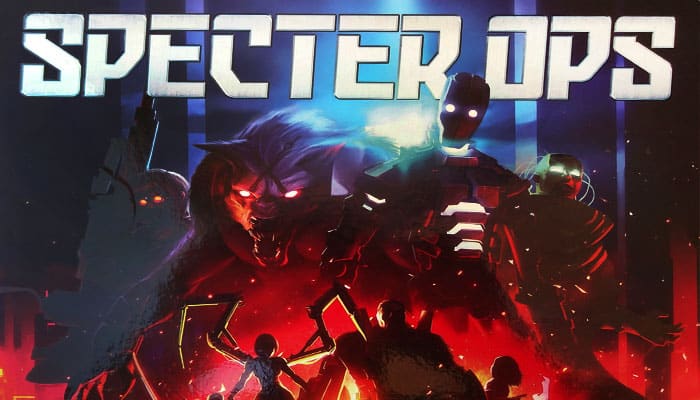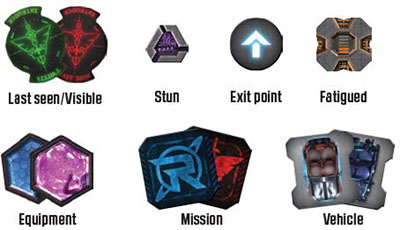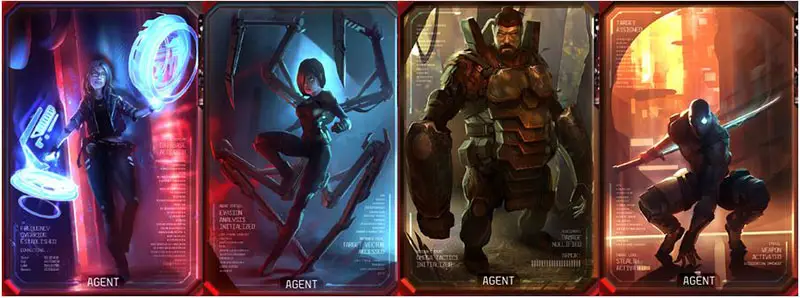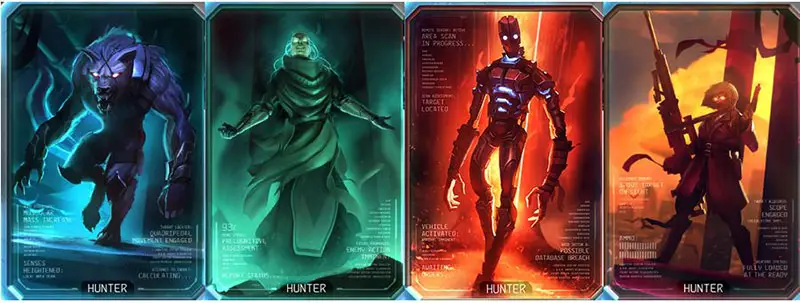
In a game of Specter Ops, one player is an A.R.K agent who has just infiltrated Raxxon Global's abandoned pharmaceutical facility in an attempt to expose information about Raxxon's past.
The other player(s) are Raxxon hunters, genetically or mechanically enhanced humans tasked with hunting down A.R.K. agents and nullifying the threat they pose to Raxxon.
Components

- 1 Game Board
- 1 Pad of Movement Sheets
- 5 Hunter Figures
- 4 Secret Role Cards
- 4 Agent Character Cards
- 8 Hunter Character Cards
- 1 Sand Timer
- 4 Agent Figures
- 1 6-Sided Dice
- 1 Dual-Sided Vehicle Card
- 29 Tokens
- 17 Equipment Cards
- 1 Rulebook
Character Card

- Name: The name of the character
- Abilities: The effects the character has on the game
- +A gent or Hunter: The character will either be an agent or a hunter
Equipment Card

- Name: The name of the equipment
- Type: The type of equipment
- Effect: The effect the equipment has when used
- Unique Symbol: Some equipment can only be used by specific agents
- Charges: The number of times the equipment can be used per game before it is discarded
Vehicle Card

- Name: The name of the vehicle
- Move: The maximum number of spaces the vehicle can be moved in a round.
- Abilities: The effect the vehicle has on the game
Tokens

Setup
The main portion of these rules describes the setup and game play for the 2-3 players.

To set up a 2-3 player game of Specter Ops, complete the following steps in order:
1 Decide which player will be the A.R.K. agent. The rest of the players will be Raxxon hunters.
2 Unfold the game board and place it in the center of the play area. Make separate piles of each token type within reach of all players.
3 The hunters choose which vehicle they will use and place the vehicle card to the side of the game board, with the appropriate side face-up. Then place the vehicle token on space K17.
4 Determine the location of the 4 mission objectives. As the agent player, roll the 6-sided die to determine where the first mission objective is located on the map in section 1. Find the objective that matches the die in section 1 and circle it on the movement sheet.
Then place a mission marker (blue Raxxon side up) on the corresponding location on the game board. Roll the 6-sided die again to determine where the second mission objective is located in section 2 of the map.
Find the objective that matches the die, circle it on the movement sheet, and place a mission marker (blue side up) on the corresponding location on the game board. Repeat this for the third and fourth mission objectives. See "Determining Mission Objectives" in the next column.
5 If playing with 3 players, each hunter player chooses 1 hunter, placing the chosen hunter figure on the vehicle card and the chosen hunter character card face up in front of him. In the 2-player game, the hunter player selects 2 hunters to play.
6 The agent player secretly chooses an agent and places that agent's character card face down in front of her. During the game, when the agent's figure would be placed on the board, the agent player reveals her character card and places the corresponding figure on the board.
7 The agent player takes all the equipment cards (except for supply cards) and secretly chooses 3 to place face down in front her. She then, without revealing them, places the rest of the cards back in the game box.
Note: The unique equipment cards are only usable by specific agents. For example: Mantis cannot use Fox's Remote Trigger.
8 Shuffle the supply equipment cards and form a face-down supply deck.
9 Put the 2-minute sand timer in reach of the players. We strongly suggest limiting the hunters' turns to 2 minutes each.
Determining Mission Objectives

The agent player rolls a 6-sided die and rolls a 2.
Looking at her movement sheet, she finds the mission objectives located in section 1. Mission objectives are indicated bH a numeral and dice icon placed on the darkened structures of the movement sheet.
Having rolled a two for section 1, she circles 1hat mission objective on her movement sheet.
The agent player then places a mission marker on the corresponding location on the game board with the blue Raxxon side of that marker facing up.
The agent player repeats this to determine the remaining 3 mission objectives.
I. Playing as an Agent

The agent player takes the first turn of the game. On her turn she will move her agent and may choose to use 1 equipment card. When she is done with her turn, play passes to the hunter player(s).
Objective
The agent player's objective is to have her agent complete any 3 of the 4 mission objectives and reach 1 of the escape points before time runs out.
Movement

The agent player will not move her agent using a figure on the game board; instead she will secretly track her agent's movement by writing on a movement sheet. The agent player controls the movement sheet during the game and is the only player that S to look at it.
The agent will start the game on space M1. On her turn the agent player may move her agent from 0to4 spaces (orthogonally and/or diagonally).

To move, she selects a path o1 up to 4 spaces, then uses the right-hand column of the movement sheet to write down which space heragent stopped its mov4ment on.
Note: The agent cannot be moved onto or through a space that is occupied by a hunter, but the agent may move around the hunter.
Note: The agent cannot be moved onto or through structures. Structures are easily identified by the areas on the board that do not have coordinate text on them.
Being seen by a Hunter
If the agent ends her move on a space that is within line of sight of a hunter, the agent is visible and must place her visible marker on that space.

If the agent moved through 1 or more spaces that are within line of sight of a hunter but didn't end her move on a visible space, she has been spotted and must place her last seen marker on the last space the agent was visible from, regardless of how many visible spaces she moved through.
Note: Whenever placing the visible or last seen marker, the agent also places her agent figure on top of that marker.
If the agent is visible when she begins her move and then moves out of sight, she must place the last seen marker on the last space she was visible from.
Using Equipment Cards

Before or after moving, the agent player may use up to 1 of the equipment cards she chose during setup. The text of an equipment card describes its effect. Equipment cards have a number of charges on them indicating how many times the card can be used per game.
Supply Caches

There are 6 supply caches on the board marked with the icon seen here. At the start of an agent player's turn, if she is on a highlighted space that has access to a supply cache, she may draw an X on her movement sheet over that supply cache and draw a card from the supply deck.
Once an agent has used a supply cache she may not use that same cache again for the rest of the game. After gaining equipment from a supply cache, the agent player takes her turn as normal.
Completing Mission Objectives

There are 4 different mission objectives. To complete a mission objective, the agent must start a turn adjacent to that objective (orthogonally or diagonally).
When the agent starts a turn adjacent to a blue Raxxon mission objective, the agent player may flip over that objectives mission marker to its red A.R.K. side to indicate that it has been completed.
Then she takes her turn normally. The agent player must complete 3 mission objectives before escaping.
Escaping and Winning
After the agent has completed 3 mission objectives she must escape. To escape she must end a move on 1 of the 3 escape points on the board. These escape points are indicated by the arrows located next to coordinates A3, M1, and W1.
If a hunter is on an escape point, the agent cannot be moved onto that space to escape. If the agent is able to achieve 3 mission objectives and escape, the agent player wins the game at the end of her turn.
Most agents start the game with 4 HP. If the agent loses all of her hit points she is captured and immediately loses the game. She also loses the game if the agent doesn't complete 3 objectives and escape by the end of round 40. The round play is currently in is public knowledge.
Becoming Fatigued

Some abilities will cause a character to become fatigued. When a character becomes fatigued, put a fatigue token on that character's card. As long as a character has a fatigue token on it, its abilities are disabled.
A disabled ability is treated as if it is no longer on the card. When a fatigued character moves 2 or fewer spaces on a turn, remove the fatigue token from it.
II. Playing as a Hunter

Note: This section of the rules is written as if there are 2 hunter players controlling 1 hunter each. The rules are the same for a single hunter player, except that player controls both hunters.
After the agent player has taken a turn, each hunter player will take 1 turn. The hunter players decide which of them will take a turn first and which will take a turn second.
On his turn, a hunter player will move his hunter and may attack a visible agent. When both hunter players have taken a turn, play passes back to the agent player.
Objective
Defeat the agent by bringing her down to 0 hit points or by preventing her from escaping before the end of the 40th round.
Movement
A hunter player will move his hunter by moving his figure on the game board. On a hunter player's turn he may move his hunter up to 4 spaces (orthogonally and/or diagonally). A hunter cannot be moved onto or through structures.
Vehicle
The hunters will start the game in the vehicle. A hunter that starts his turn in a vehicle may move the vehicle instead of the hunter. To move the vehicle, move the vehicle token (orthogonally and/or diagonally) on the game board.
The vehicle can only be moved on road spaces. Road spaces can be identified on the game board as the coordinates adjacent to dashed lines. The vehicle cannot be moved more spaces than its move value in a single round.
Example: Both hunters are in the Tracer at the start of this round. The first hunter player moves the vehicle 6 spaces before exiting the vehicle with his hunter. The second hunter player may now only move the vehicle up to 4 spaces on his turn, for a total of 10 spaces.
Entering or exiting the vehicle with a hunter immediately ends that hunter's movement for the turn. To enter the vehicle, a hunter player must move his hunter onto the vehicle token and then place his figure on the vehicle card.
To exit the vehicle, a hunter player removes his figure from the vehicle card and places it on the game board on a space adjacent to the vehicle token.
Agents and hunters can be moved onto or through the vehicle. The vehicle does not block line of sight. Being in the vehicle does not impair a hunter's sight in any way. Hunters can still use their abilities in a vehicle, but a hunter in the vehicle cannot attack. A hunter cannot be stunned while he is in the vehicle. Vehicles are not limited to 4 occupants.
Seeing an Agent
At the end of a hunter's move, the agent player must say "clear" if the agent is NOT visible to that hunter. If the agent IS visible to that hunter the agent player must place her visible marker on the game board on the space the agent currently occupies.
Line of sight is only checked at the end of each hunter's move. Therefore, it's possible to move a hunter past the agent without detecting her presence.
Attacking
After a hunter moves, if the agent is visible to that hunter, that hunter may attack the agent. To attack the agent, roll the 6-sided die and count out the number of spaces away the agent is from the attacking hunter.
The agent is hit on a roll equal to or greater than that number. If the attacking hunter is on the same space as the agent, no die is rolled. Instead, the attack automatically hits. Each hit inflicts 1 HP of damage. (An agent's HP is tracked on the movement sheet).
When attacking, a roll of 1 is an automatic miss. If a 6 is rolled the hunter player may roll the die again and add the new value to his previous roll; he may continue doing this every time he rolls a 6. Therefore it is always possible to hit the agent regardless of the distance.
Note: A hunter cannot attack while in the vehicle.
Hunter Vision
On the game board a hunter has line of sight down the row and column it is on. There is no range limit to its line of sight but it can't see through structures. If a hunter is on a road, it is able to see down the stretch of road as well as line of sight down the row and column it is on.

Stunned Hunter
Some abilities will cause a hunter to become stunned. When a hunter becomes stunned, place a stun token on that hunter's character card. While stunned, that hunter cannot attack or use his abilities, and can only be moved up to 2 spaces during his turn.
At the end of a stunned hunter's turn, remove the stun token from its card. It is no longer stunned. A hunter cannot be stunned while he is in the vehicle.
Defeating the agent and Winning
Most agents start the game with 4 HP. If the agent loses all of her HP, the hunter players immediately win the game. The hunter players also win the game if the agent doesn't complete 3 objectives and escape by the end of round 40. The round play is currently in is public knowledge.
Timed Turns
There is a 2-minute sand timer included in this set. We strongly recommend using it to limit the length of each hunter's turn.
Pets
Some hunters have a pet. A pet is represented with a figure and starts the game in the vehicle. After a player takes a turn with a hunter that has a pet, he may take a turn with that pet.
A pet can be moved following all of the rules for moving a hunter, except a pet cannot drive (move) the vehicle or use its special ability. A pet cannot be stunned. A pet does not attack or have vision except as described in its hunter's abilities. The agent may move through a pet.
Continue Reading

